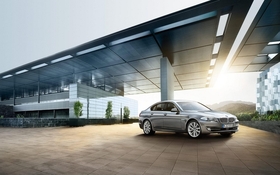2011 BMW 550i: An ICBM For the Rest of Us

| Strong points |
|
|---|---|
| Weak points |
|
At 110 kilometres per hour, it barely felt like it was stretching its legs. Sloughing off the assaults of a buffeting crosswind and impervious to the needling of the irregular pavement surface, there was no doubt in my mind that BMW’s obviously expansive engineering department spent a significant amount of time at stratospheric speeds in order to reach this level of grand touring perfection. Of course, whilst those Bavarian brainiacs may have been able to enjoy the effortless liberty of the autobahn, I was limited by the legality of Canadian highways, which meant I had some time on my hands with which to ponder the BMW 550i I found myself within.
It was new, that much had been obvious from the first moment I laid my eyes on it. Borrowing heavily from the 7-series design in an effort to leave behind the work of Chris Bangle, it replaces the flame-surfaced and admittedly interesting styling of the previous 5-series with the stoic, upright nature that so many BMWs before have been imbued with. The grill and lights, almost vertical in orientation, are much more stately than Bangle’s exquisitely sculptured units. The car’s flanks, free of lighthearted sweeping creases and character lines, emphasize the car’s wide track and well-planted nature just as well as the new 7-series’ do. And out back, the oft-maligned Bangle butt of the old 5 is a distant memory compared to the staid derriere that one now finds in its place.
But all that upright architecture does have an upside: a very comfortable and spacious cabin. Having had the pleasure of operating a few classic BMW coupes, I won’t go as far as saying that this new 5-er really invokes the same sensation of airiness… but it’s as close as you’re going to get with modern day crash and rollover standards. The columns aren’t exactly the same spidery wisps you’ll find in a 3.0 CS or 2002, but the expanses of glass between them are large and quite vertical. Combined with the relatively tall seating position, they give an excellent view of the passing countryside.
That is, of course, only if you can pry your eyes off the various gizmos and gadgets that are scattered around the interior, where further evidence of the 5-series’ upward migration exists. Seemingly lifting as much of its style from the 7 as possible, the new car definitely features a more holistic design overall, with a wide dashboard that’s far more squat in profile than the old one. Long gone is the tall, widely-spaced center control stack and prominent iDrive display aperture; replaced by a short control stack and slightly deeper-set (and lower) display. As a result, the cabin doesn’t feel like it’s quite so divided down the middle, which helps the car feel a lot more open inside. However, should you reach across the center console to, oh say, hold a passenger’s hand, you’ll find they’re actually pretty far away. Evidently in shortening the dashboard’s profile, they’ve had to stretch things out horizontally.
Or perhaps they’ve just had to make the whole thing bigger in order to fit all the technology they’ve stuffed into it. The biggest crowd pleaser, and arguably the most impressive, is definitely the night vision system. Although not a new feature by any stretch, it never ceased to amaze me with exactly how impressive it is; oftentimes detecting raccoons and pedestrians dozens upon dozens of yard before the headlights illuminated them. But another feature, a far newer one, is definitely the big news: adaptive drive. Attempting to further the 5-series’ already impressive ability to be everything to everyone, the new system allows the driver to tailor the various engine and suspension settings to suit their tastes. With settings ranging from Comfort to Sport Plus, it can take the car from luxo-barge to tingling sports sedan in seconds.
But regardless of what setting it in, there can be no denying the single best attribute of this particular car: the powerplant. Producing 400 horsepower, it’s the manner in which it creates this power that’s most impressive. Using a pair of turbochargers strapped to a 4.4 litre V8, it probably best described as turbine-like in its power production. Spooling up like a jet on run-up, it pulls the car forward like some sort of gigantic elastic band fastened to the grill, building pace with alarmingly sedate alacrity. There’s no high-rpm scream or abrupt downshifts to accompany the giant hand pushing your chest into the seat. No, just the sudden increase in the ate of the white lines flying past and a barely perceptible change in wind noise is all the outside indication you get that you’re nearing criminal statute-invoking velocity.
And it is that effortless ability to obtain and maintain ridiculous velocity that brought about my autobahn-themed musings in the first place. Pairing BMW’s nigh-perfect ability to tune a chassis with enough technology to launch something into orbit, the new 550i brings a slightly fresh take on the mid-size BMW sport sedan recipe. Obviously looking to move it substantially upmarket with its new styling and enlarged footprint, the new car is quite a bit more luxurious than the old one; trading its youthful vim and vigor for a slightly more upscale, relaxed atmosphere. When asked, it will still prove spry enough, but it seems to be at its best when left to just rail along big, expansive stretches of highway… just as it was intended to.











